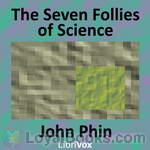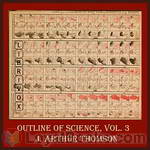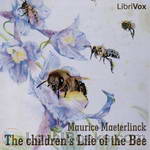|
Books Should Be Free Loyal Books Free Public Domain Audiobooks & eBook Downloads |
|
|
Books Should Be Free Loyal Books Free Public Domain Audiobooks & eBook Downloads |
|
Science |
|---|
|
Book type:
Sort by:
View by:
|
By: Murray Leinster (1896-1975) | |
|---|---|
 The Ambulance Made Two Trips
The Ambulance Made Two Trips
Big Jake Connors is taking over his town through violence, inimidation and bribery but Detective Sergeant Fitzgerald can only grind his teeth in frustration. The gangsters seem to have everything going their way until the day that a little dry cleaning establishment declines their offer of 'protection' and strange things start to happen. Murray Leinster gives us another wonderful product of 'what if' from his limitless imagination to enjoy in this gem of a story. Listen and smile. | |
By: Aristotle (384 BCE-322 BCE) | |
|---|---|
 Parva Naturalia
Parva Naturalia
Parva Naturalia [the "short treatises on nature" (a conventional Latin title first used by Giles of Rome)] is a collection of books by Aristotle, which discuss natural phenomena involving the body and the soul. The books are as follows:I - On Sensation and the SensibleII - On Memory and RecollectionIII - On Sleeping and WakingIV - On DreamsV - On Prophecy in SleepVI - On Longevity and Shortness of LifeVII - On Youth and Old Age, Life and Death VIII - On Respiration | |
By: John Phin (1830-1913) | |
|---|---|
 The Seven Follies of Science
The Seven Follies of Science
The seven follies of science; a popular account of the most famous scientific impossibilities and the attempts which have been made to solve them to which is added a small budget of interesting paradoxes, illusions, and marvels. | |
By: Charles Godfrey Leland (1824-1903) (1824-1903) | |
|---|---|
 The Mystic Will
The Mystic Will
This book presents a method of developing and strengthening the faculties of the mind, through the awakened will, by a simple, scientific process possible to any person of ordinary intelligence | |
By: Gaston Maspero (1846-1916) | |
|---|---|
 Manual of Egyptian Archaeology and Guide to the Study of Antiquities in Egypt
Manual of Egyptian Archaeology and Guide to the Study of Antiquities in Egypt
A handbook of Egyptian archaeology, issued by the British Museum, considered suitable for British tourists travelling to Egypt in the 19th Century. (Introduction by Timothy Ferguson) | |
By: J. Arthur Thomson (1861-1933) | |
|---|---|
 The Outline of Science Vol. 3
The Outline of Science Vol. 3
The Outline of Science was written specifically with the man-on-the-street in mind as the target audience. Covering scientific subjects ranging from astronomy to biology to elementary physics in clear, concise and easily understood prose, this popular science work is largely as relevant today as when first published in 1922.In this third volume (of four), we learn about psychic science, the characteristics and interrelations of living creatures, as well as Botany, Biology, and Chemistry. Some chapters are devoted to the new applied sciences of electricity, telegraphy, and flying. | |
By: David Hilbert (1862-1943) | |
|---|---|
 Mathematical Problems
Mathematical Problems
Lecture delivered before the International Congress of Mathematicians at Paris in 1900 and subsequently published in the Bulletin of the American Mathematical Society Vol. 8 (1902), 479-481. | |
By: Plato (424-348 BC) | |
|---|---|
 Laws
Laws
Νόμοι (Laws) is Plato's final dialogue written after his attempt to advise the tyrant Dionysius II of Syracuse. The dialogue takes place between: an Athenian Stranger (Socrates? A god in human form?); the quiet Lacedaemonian Megillus; and the Cretan Cleinias. The Stranger asks whether humans live to be more effective at waging war or if there is something more important a legislator should seek to achieve. During their pilgrimage Cleinias discloses his role in the establishment of a new colony... | |
By: Grenville A. J. Cole (1859-1924) | |
|---|---|
 Rocks and Their Origins
Rocks and Their Origins
Do you know the difference between sedimentary, igneous and metamorphic rocks? Are you interested in their geologic origin, chemical composition or how each type affects the landscape? Do you know the differences between limestone, granite and marble as building materials? You will find these and lots of other interesting facts about rocks in this second edition of "Rocks and Their Origins" published in 1922. The author, Grenville A. J. Cole, was an English geologist, Professor of Geology in the Royal College of Science for Ireland and an avid cyclist. | |
By: Frederick Czapek (1868-1921) | |
|---|---|
 Chemical Phenomena in Life
Chemical Phenomena in Life
Published in 1911 as part of the "Harper's Library of Living Thought," this volume presents an introduction to the chemistry of cells in the context of plant physiology and gives an interesting overview of the field of biochemistry and related sciences at the time. The author, Frederick Czapek, was a Czech botanist and professor of Plant Physiology at the University of Prague. He is perhaps best known for his two-volume work on Plant Physiology, "Biochemie der Pflanzen" and for Czapek solution agar or Czapek-Dox medium, a culture medium for cultivation of fungus species such as Aspergillus and Penicillium molds. ( | |
By: Maurice Maeterlinck (1862-1949) | |
|---|---|
 The children's Life of the Bee
The children's Life of the Bee
Buzz, buzz, buzz. A fascinating and beautifully written explanation of the life of the honey bee. Is the queen the master of the hive or just a hard working servant? What is the purpose of the drones? Why do bees make honey? Do bees ever sleep? Why do bees swarm? Maeterlinck, who won the Noble Prize for Literature, wrote a more scholarly work called The Life of the Bee but then rewrote it in simpler terms so that children could appreciate what goes in a hive. The book describes in simple language the inner workings of a hive from its beginning with a swarm to the fully functional hive with thousands of workers, drones and a queen busily building, repairing and gathering. | |
By: Margaret Burnham | |
|---|---|
 The Girl Aviators and the Phantom Airship
The Girl Aviators and the Phantom Airship
Teenagers Peggy Prescott and her brother Roy share a love of aviation that they inherited from their late father. Mr. Prescott had always dreamed of building an aeroplane that would be free of the defects of planes already invented. Peggy and Roy manage to build a plane starting with the framework their father had begun. Peggy christens it ‘The Golden Buttefly’ and she and Roy are determined to enter it in a young aviator’s contest for a prize of $5000. The Prescotts need the money desperately to save the home they share with their aunt which is about to be taken from them by the rather nasty banker, Mr... | |
By: Mary Huestis Pengilly | |
|---|---|
 Diary Written in the Provincial Lunatic Asylum
Diary Written in the Provincial Lunatic Asylum
Mary Pengilly was taken to a Lunatic Asylum by her sons where she kept a diary, which this book is taken from. Mary records the harsh conditions and treatments received at the hands of the nurses during her stay. Once Mary is released she takes it upon herself to make the authorities aware of the situation at the Provincial Lunatic Asylum. | |
By: William Ruschenberger (1807-1895) | |
|---|---|
 The Elements of Entomology
The Elements of Entomology
The Elements of Entomology is one of seven in a Series of First Books of Natural History Prepared for the Use of Schools and Colleges. It is a succinct little textbook from 1845 presents an introduction to entomology. The author was a surgeon in the U.S. Navy and president of the Academy of Natural Sciences. | |
By: Anonymous | |
|---|---|
 Young Girl's Diary
Young Girl's Diary
The diary of an upper middle class Austrian girl, this book describes her life between the ages of eleven and fourteen. It's a coming of age story full of angst, boys, and questions. | |
By: Various | |
|---|---|
 National Geographic Magazine Vol. 01 No. 2
National Geographic Magazine Vol. 01 No. 2
National Geographic Magazine Volume 1 Number 2 published in 1889. Topics of articles are:Africa, its Past and Future Reports on:Geography of the LandGeography of the SeaGeography of the AirGeography of Life | |
By: Plato (Πλάτων) (c. 428 BC - c. 347 BC) | |
|---|---|
 Republic (version 2)
Republic (version 2)
The Republic is a Socratic dialogue written by Plato around 380 BC concerning the definition of justice and the order and character of the just city-state and the just man. It is Plato's best-known work and has proven to be one of the most intellectually and historically influential works of philosophy and political theory. In it, Socrates along with various Athenians and foreigners discuss the meaning of justice and examine whether or not the just man is happier than the unjust man by considering a series of different cities coming into existence "in speech", culminating in a city (Kallipolis) ruled by philosopher-kings; and by examining the nature of existing regimes... | |
 Gorgias
Gorgias
This dialogue brings Socrates face to face with the famous sophist Gorgias and his followers. It is a work likely completed around the time of "Republic" and illuminates many of the spiritual ideas of Plato. The spirituality, as Jowett points out in his wonderful introduction, has many ideas akin to Christianity, but is more generous as it reserves damnation only for the tyrants of the world. Some of the truths of Socrates, as presented by Plato, shine forth in this wonderful work on sophistry and other forms of persuasion or cookery. | |
By: John D. Rockefeller (1839-1937) | |
|---|---|
 Random Reminiscences of Men and Events
Random Reminiscences of Men and Events
A good book by the oil revolutionist of the 20th century. As they say "Men should listen to experience" and this book is all about the experience of the second highest taxpayer of the US during the 20's. Though it is not in the book, this is a small poem he wrote:I was early taught to work as well as play,My life has been one long, happy holiday;Full of work and full of play-I dropped the worry on the way- And God was good to me everyday. | |
By: Selina Gaye (1840-1914) | |
|---|---|
 The World's Lumber Room
The World's Lumber Room
If this book were written today, it would be called "The Story of the World's Rubbish".That may not sound a promising subject for a book, but we are taken on a journey all over the world (and beyond) to explain the many varieties of dust and refuse - animal, vegetable and mineral - how it is made both by man and by nature, what happens to it, and why we need it. We find that recycling is nothing new: man has been doing it for centuries, and nature has been doing it for billions of years. As every schoolboy knows, 'matter is neither created nor destroyed', so it stands to reason that every particle of it must be somewhere... | |
By: Robert Goadby (1721-1778) | |
|---|---|
 Surprising Adventures of Bampfylde Moore Carew, King of the Beggars
Surprising Adventures of Bampfylde Moore Carew, King of the Beggars
The Surprising Adventures of Bampfylde Moore Carew recounts the wide-ranging exploits of a real-life rogue – a wily professional mendicant who roams 18th-century England extracting charity from merchants, clergyman, and members of the landed gentry alike, employing in his craft an ingenious variety of deceptions and disguises put on for the purpose. Often he impersonates a shipwreck-surviving seaman and uses his wide knowledge of foreign parts and personages to achieve plausibility. Or he might appear on a doorstep as a destitute woman in widow's weeds, toting borrowed babes to enhance the effect... | |
By: B. G. Jefferis and J. L. Nichols | |
|---|---|
 Searchlights on Health
Searchlights on Health
SEARCHLIGHTS ON HEALTH. THE SCIENCE OF EUGENICSBy PROF. B.G. JEFFERIS, M.D., PH. D. KNOWLEDGE IS SAFETY. 1. The old maxim, that Knowledge is power, is a true one, but there is still a greater truth: KNOWLEDGE IS SAFETY. Safety amid physical ills that beset mankind, and safety amid the moral pitfalls that surround so many young people, is the great crying demand of the age. 2. CRITICISM.--This work, though plain and to some extent startling, is chaste, practical and to the point, and will be a boon and a blessing to thousands who consult its pages... | |
By: Francis M. Walters | |
|---|---|
 Physiology and Hygiene
Physiology and Hygiene
Physiology and Hygiene for Secondary Schoolsby Francis M. Walters, A.M.PREFACE The aim in the preparation of this treatise on the human body has been, first, to set forth in a teachable manner the actual science of physiology; and second, to present the facts of hygiene largely as applied physiology. The view is held that right living consists in the harmonious adjustment of one's habits to the nature and plan of the body, and that the best preparation for such living is a correct understanding of the physical self... | |
By: Various | |
|---|---|
 A Book of Natural History
A Book of Natural History
YOUNG FOLKS' LIBRARYA BOOK OF NATURAL HISTORYTHE WONDER OF LIFE, BY PROFESSOR, T. H. HUXLEY. Every one has seen a cornfield. If you pluck up one of the innumerable wheat plants which are fixed in the soil of the field, about harvest time, you will find that it consists of a stem which ends in a root at one end and an ear at the other, and that blades or leaves are attached to the sides of the stem. The ear contains a multitude of oval grains which are the seeds of the wheat plant. You know that when these seeds are cleared from the husk or bran in which they are enveloped, they are ground into fine powder in mills, and that this powder is the flour of which bread is made... | |
By: Leonardo da Vinci | |
|---|---|
 The Notebooks of Leonardo Da Vinci
The Notebooks of Leonardo Da Vinci
The Notebooks of Leonardo Da VinciPREFACEA singular fatality has ruled the destiny of nearly all the most famous of Leonardo da Vinci's works. Two of the three most important were never completed, obstacles having arisen during his life-time, which obliged him to leave them unfinished; namely the Sforza Monument and the Wall-painting of the Battle of Anghiari, while the third--the picture of the Last Supper at Milan--has suffered irremediable injury from decay and the repeated restorations to which it was recklessly subjected during the XVIIth and XVIIIth centuries... | |
By: Bertha M. Clark | |
|---|---|
 General Science
General Science
GENERAL SCIENCEBY BERTHA M. CLARK, PH.D.PREFACEThis book is not intended to prepare for college entrance examinations; it will not, in fact, prepare for any of the present-day stock examinations in physics, chemistry, or hygiene, but it should prepare the thoughtful reader to meet wisely and actively some of life's important problems, and should enable him to pass muster on the principles and theories underlying scientific, and therefore economic, management, whether in the shop or in the home. We... | |
By: Various | |
|---|---|
 Young Folks' Library
Young Folks' Library
Young Folks' Library, Selections from the Choicest LiteratureTHE MARVELS OF NATURE BY EDWARD S. HOLDEN, M.A., Sc.D. LL.D. The Earth, the Sea, the Sky, and their wonders--these are the themes of this volume. The volume is so small, and the theme so vast! Men have lived on the earth for hundreds of the sands of years; and its wonders have increased, not diminished, with their experience. To our barbarous ancestors of centuries ago, all was mystery--the thunder, the rainbow, the growing corn, the ocean, the stars... | |
By: Robert Burton (1577-1640) | |
|---|---|
 Anatomy of Melancholy Volume 3
Anatomy of Melancholy Volume 3
The Anatomy of Melancholy is a book by Robert Burton, first published in 1621. On its surface, the book is a medical textbook in which Burton applies his large and varied learning in the scholastic manner to the subject of melancholia (which includes what is now termed clinical depression). Though presented as a medical text, The Anatomy of Melancholy is as much a sui generis work of literature as it is a scientific or philosophical text, and Burton addresses far more than his stated subject. In... | |
By: Charles Darwin (1809-1882) | |
|---|---|
 Formation of Vegetable Moulds through the Action of Worms with Observations on their Habits
Formation of Vegetable Moulds through the Action of Worms with Observations on their Habits
Charles Darwin LL.B F.R.S was the discoverer of evolution and argued the role of "natural selection" in directing the evolution of species. Darwin also had an interest in the formation of soils (moulds) that began relatively early in his life, with a paper "On the Formation of Vegetable Moulds" delivered to the Geological Society of London in 1937. Darwin's last book, The Formation of Vegetable Moulds through the Action of Worms with Observations on their Habits, was completed in 1881. | |
By: Hallam Hawksworth (1863-?) | |
|---|---|
 Adventures of a Grain of Dust
Adventures of a Grain of Dust
This charming book for children is full of interesting facts about all sorts of plants, insects, birds and animals and how they all help to enrich the soil for farmers - each in its own special way. Join our narrator, The Grain of Dust on a fascinating journey around the planet to meet them. "I don't want you to think that I'm boasting, but I do believe I'm one of the greatest travellers that ever was; and if anybody, living or dead, has ever gone through with more than I have I'd like to hear about it... | |
By: Richard Swann Lull (1867-1957) | |
|---|---|
 Organic Evolution
Organic Evolution
Organic Evolution is a college textbook that describes the mechanism of biological evolution by natural selection. It then explores the evidences for evolution in various animals, including insects, reptiles, birds and humans, mainly from the science of paleontology. | |
By: Various | |
|---|---|
 National Geographic Magazine Vol. 01 No. 3
National Geographic Magazine Vol. 01 No. 3
National Geographic Magazine Volume 1 Number 3 published in 1889. Topics of articles are: The Rivers and Valleys of Pennsylvania Topographic Models International Literary Contest | |
By: An Anti-Slavery Convention of American Women (1837-1837) | |
|---|---|
 Address to Free Colored Americans
Address to Free Colored Americans
The first Anti-Slavery Convention of American Women met in New York City in May, 1837. Members at the Convention came from all walks of life and included such prominent women as Mary Parker, Lucretia Mott, the Grimke sisters, and Lydia Maria Child. One outcome of this important event was a statement of the organization’s role in the abolitionist movement as expressed in AN ADDRESS TO FREE COLORED AMERICANS, which begins: “The sympathy we feel for our oppressed fellow-citizens who are enslaved... | |
By: Aristotle (384 BC - 322 BC) | |
|---|---|
 Physics
Physics
Physics (Greek: Φυσικὴ ἀκρόασις; Latin: Physica, or Physicae Auscultationes) discusses concepts including: substance, accident, the infinite, causation, motion, time and the Prime Mover. | |
By: Anna Botsford Comstock (1854-1930) | |
|---|---|
 Handbook of Nature-Study, Part 1
Handbook of Nature-Study, Part 1
Handbook of Nature-Study was written by Anna Botsford Comstock during an era of growing societal concern for man's treatment of the natural world. Out of this concern grew the nature study movement which sought to teach science to school children (and others) through direct observation of nature by the students themselves instead of by the study of nature books. The book is written as a guide for teachers instructing their classes in nature study and includes a wealth of information about plants, animals, the earth, and the sky along with suggestions for guiding students in their observations... | |
By: United States House of Representatives | |
|---|---|
 Failure of Initiative: Final Report of the Select Bipartisan Committee to Investigate the Preparation for and Response to Hurricane Katrina
Failure of Initiative: Final Report of the Select Bipartisan Committee to Investigate the Preparation for and Response to Hurricane Katrina
In September 2005, the House of Representatives created the Select Bipartisan Committee to Investigate the Preparation for and Response to Hurricane Katrina. The Committee was charged with conducting "a full and complete investigation and study and to report its findings to the House not later than February 15, 2006, regarding-- (1) the development, coordination, and execution by local, State, and Federal authorities of emergency response plans and other activities in preparation for Hurricane Katrina; and (2) the local, State, and Federal government response to Hurricane Katrina... | |
By: Ed Clark | |
|---|---|
 Constructive Beekeeping
Constructive Beekeeping
The author explores the effects of condensation and evaporation as they relate to the success of a beehive. The results of various experiments and the author's thoughts are given. | |
By: Charles George Harper (1863-1943) | |
|---|---|
 Revolted Woman
Revolted Woman
One man's opinion of woman in 1894. Charles Harper believes in the superiority of the male sex and the subordination of the female. He paints an entire gender with the same brush. He believes all women to be identical in mind (illogical) and body (knock-kneed) and vastly inferior to the male. He presents 'facts' to support his opinions: "Woman's Mission is Submission" "for woman has ever been the immoral sex" "how truly like nature their tongues say 'No,' when their hearts throb 'Yes, yes!'" "She... | |
By: Jean-Henri Fabre (1823-1915) | |
|---|---|
 Secret of Everyday Things
Secret of Everyday Things
The clearness, simpicity, and charm of the great French naturalist's style are nowhere better illustrated than in this work, which in its variety of subject-matter and apt use of entertaining anecdote rivals "The Story-Book of Science," already a favorite with his readers. Such instances of antiquated usage or superseded methods as occur in these chapters of popular science easily win our indulgence because of the literary charm and warm human quality investing all that the author has to say. -- Translator (Introductory Note). | |
By: National Comm. on the BP Deepwater Horizon Oil Spill | |
|---|---|
 Final Report from the National Commission on the BP Deepwater Horizon Oil Spill and Offshore Drilling
Final Report from the National Commission on the BP Deepwater Horizon Oil Spill and Offshore Drilling
On April 20, 2010, the Macondo well blew out, costing the lives of 11 men, and beginning a catastrophe that sank the Deepwater Horizon drilling rig and spilled over 4 million barrels of crude oil into the Gulf of Mexico. The spill disrupted an entire region's economy, damaged fisheries and critical habitats, and brought vividly to light the risks of deepwater drilling for oil and gas - the latest frontier in the national energy supply. Soon after, President Barack Obama appointed a seven-member Commission to investigate the disaster, analyze its causes and effects, and recommend the actions necessary to minimize such risks in the future... | |
By: Abraham Lincoln (1809-1865) | |
|---|---|
 Emancipation Proclamation
Emancipation Proclamation
After having written and released an initial draft of this proclamation in September of 1862, minor changes were made and Lincoln signed it on January 1st, 1863. It declared free the slaves in 10 states not then under Union control, with exemptions specified for areas already under Union control in two states. Lincoln spent the next 100 days preparing the army and the nation for emancipation, while Democrats rallied their voters in the 1862 off-year elections by warning of the threat freed slaves posed to northern whites... | |
By: Hans Gross (1847-1915) | |
|---|---|
 Criminal Investigation: a Practical Handbook for Magistrates, Police Officers and Lawyers, Volume 1
Criminal Investigation: a Practical Handbook for Magistrates, Police Officers and Lawyers, Volume 1
Reputedly inspired by the Sherlock Holmes stories, Austrian criminal jurist and examining magistrate Hans Gross wrote the first handbook on criminal investigation. This treatise covers everything from the qualities of a good investigating officer and how to utilize various experts, to tactics employed by criminals, how to analyze footprints and blood stains, and ways that criminals perpetrate crimes. Some of the remarks relate directly to India, such as disguising one's caste.Volume 1 (of 3) consists of Part 1 of the 4 parts in the work. | |
By: Francis Rolt-Wheeler (1876-1960) | |
|---|---|
 Science - History of the Universe Vol. 1: Astronomy
Science - History of the Universe Vol. 1: Astronomy
Multi-volume work on science edited by Francis Rolt-Wheeler. The first volume is on Astronomy written by Waldemar Kaempffert. This book briefly discusses the evolution of astronomical beliefs and the development of instruments and progress of methods in the science. It explains, further, the different astronomical laws, theories, phenomena and objects, as well as the history of these discoveries. | |
By: William Ruschenberger (1807-1895) | |
|---|---|
 Elements of Mammalogy
Elements of Mammalogy
The Elements of Mammalogy is one of seven in a Series of First Books of Natural History Prepared for the Use of Schools and Colleges. This succinct little textbook from 1845 presents an introduction to mammalogy. The information, albeit not current, is still interesting and of use as a general overview of mammal biology. The classification of mammals has changed considerably since this time. The author was a surgeon in the U.S. Navy and president of the Academy of Natural Sciences. | |
By: Constantine Panunzio (1884-1964) | |
|---|---|
 Deportation Cases of 1919-1920
Deportation Cases of 1919-1920
"The study here presented embodies the findings of an investigation into the recent [1919-1920] deportations of persons deemed to be unlawfully in the country. . . Its purpose is to call public attention to practices that are inconsistent with the American tradition of justice and fair-play." | |
By: A. T. Anderson (?-?) | |
|---|---|
 How to Do Chemical Tricks
How to Do Chemical Tricks
While a bit outdated in many of the more complex descriptions of several of the phenomena described, this book is nonetheless still fun and relevant for a person interested in basic chemistry or physics tricks, and the devices built in the book can be easily replicated with more modern materials. The book is split up into many little experiments, tricks, with an explanation on how it works, what's happening, and how to reproduce the effects at home. | |
By: Sir William Henry Bragg (1862-1942) | |
|---|---|
 World of Sound
World of Sound
The World of Sound consists of six lectures delivered before a juvenile audience at the Royal Institution, Christmas 1919. The Royal Institution Christmas Lectures are a series of lectures on a single topic, which have been held at the Royal Institution in London each year since 1825, except several years during the Second World War. The lectures present scientific subjects to a general audience, including young people, in an informative and entertaining manner. Michael Faraday initiated the first Christmas Lecture series in 1825, at a time when organised education for young people was scarce... | |
By: Various | |
|---|---|
 Selection of 19th Century Scientific Verse
Selection of 19th Century Scientific Verse
In the 18th and early 19th centuries, it was common for discoveries in branches of science such as botany, astronomy and medicine to be described in book-length treatises in verse. By the end of the 19th century this mode of popularising science was falling from favour as the studies of science and the humanities diverged and study became more specialised.This small selection of somewhat lighter-hearted verse written by distinguished scientists and mathematicians of the day includes poems by James Clerk Maxwell, William J. Macquorn Rankine and James Joseph Sylvester. | |
By: William Ruschenberger (1807-1895) | |
|---|---|
 Elements of Ornithology
Elements of Ornithology
The Elements of Ornithology is one of seven in a Series of First Books of Natural History Prepared for the Use of Schools and Colleges. This succinct little textbook from 1845 presents an introduction to ornithology. The information, albeit not current, is still interesting and of use as a general overview of bird biology and classification. The author was a surgeon in the U.S. Navy and president of the Academy of Natural Sciences. | |
By: Vernon Kellogg (1867-1937) | |
|---|---|
 Insect Stories
Insect Stories
These 13 essays explore the fascinating world of insects all around us. Vernon Kellogg, an eminent entomologist and natural story teller, and his little friend Mary, start by collecting Tarantula Holes and proceed to observe spiders, ant lions, ants, wasps and many other tiny creatures in their daily life. Each creature has a wonderful story and it is told most entertainingly. | |
By: D. B. Casteel (1877-1958) | |
|---|---|
 Behavior of the Honey Bee in Pollen Collecting
Behavior of the Honey Bee in Pollen Collecting
The value of the honey bee in cross pollinating the flowers of fruit trees makes it desirable that exact information be available concerning the actions of the bee when gathering and manipulating the pollen. The results recorded in this manuscript are also of value as studies in the behavior of the bee and will prove interesting and valuable to the bee keeper. The work here recorded was done by Dr. Casteel during the summers of 1911 and 1912. | |
By: Grace Coleridge Frankland (1858-1946) | |
|---|---|
 Bacteria in Daily Life
Bacteria in Daily Life
The author provides a fascinating look at the emerging science of bacteriology at the start of the twentieth century including early progress in understanding and preventing diseases such as tuberculosis and diphtheria. The book also includes chapters on the spread of disease through close contact with infected persons as well as from contaminated drinking water and milk. Water purification methods as well as the stability of various disease-causing organisms to extremes of heat and cold is discussed... | |
By: William Walker Atkinson (1862-1932) | |
|---|---|
 Memory: How to Develop, Train and Use It
Memory: How to Develop, Train and Use It
An in-depth series of chapters devoted to the use of our memory system; as the title suggests, how to develop our memory system, how to train it to improve it, and how to make the best use of it in our everyday lives, and to improve our positions in life. This is not intended to be a series of chapters to impress friends and colleagues, nor to play 'tricks' on others, rather it is for the betterment of individuals in whatever walk of life in which they may be involved by training and using their memory toward that end. | |
By: Dr. Albert Philip Sy (1872-?) | |
|---|---|
 Food Values
Food Values
A short pamphlet from WWI, a sequel of sorts to "Food Preparedness." It first describes basic nutrition and things to consider when choosing what foods to eat, then lists various foods and their amount of calories, carbohydrates, fats, proteins, water, and "ash". This was written before much was known about fat soluble vitamins or saturated vs. unsaturated fats. | |
By: Various | |
|---|---|
 National Geographic Magazine Vol. 01 No. 4
National Geographic Magazine Vol. 01 No. 4
National Geographic Magazine Volume 1 Number 4 published in 1889. Topics of articles are: Irrigation in California Round about Asheville A Trip to Panama and Darien Across Nicaragua with Transit and Machéte | |
By: Emma Goldman (1869-1940) | |
|---|---|
 Deportation: Its Meaning and Menace. Last Message to the People of America
Deportation: Its Meaning and Menace. Last Message to the People of America
A pamphlet written by Alexander Berkman and Emma Goldman shortly before their deportation from the US in 1919. | |
By: Mason Long (1842-1903) | |
|---|---|
 Save the Girls
Save the Girls
Save the Girls is an 1880 American anti-white-slavery book by reformed gambler Mason Long. In it, the author crusades against the social evil of prostitution by presenting a series of pathetic portraits of young women from various social classes who are brought low by such temptations of city life as the theater, the racecourse, and street flirtations. Included are vignettes of vice like "The Evils of Dancing - Sad Results of a Public Ball," in which innocent Marie, out for a good time, falls prey to the type of 'sporting men' who prowl such events in search of a partner for more than just The Glide or the Boston Dip. | |
By: Arabella B. Buckley (1840-1929) | |
|---|---|
 Through Magic Glasses and Other Lectures
Through Magic Glasses and Other Lectures
"The present volume is chiefly intended for those of my young friends who have read, and been interested in, The Fairyland of Science. It travels over a wide field, pointing out a few of the marvellous facts which can be studied and enjoyed by the help of optical instruments. It will be seen at a glance that any one of the subjects dealt with might be made the study of a lifetime, and that the little information given in each lecture is only enough to make the reader long for more.In these days,... | |
By: Mary Antin (1881-1949) | |
|---|---|
 They Who Knock at Our Gates
They Who Knock at Our Gates
In 1914, over one million immigrants arrived in the United States, following in the footsteps of approximately ten million others who had arrived in the preceding decade. Faced with so many newcomers, many of them from backgrounds new to the American mix, voices in government and in the press had begun arguing in favor of more severely restrictionist immigration policies. In They Who Knock at Our Gates, Mary Antin broke down the discussion into three basic questions. First, the ethical question --... | |
By: Henry Fielding (1707-1754) | |
|---|---|
 Enquiry Into The Causes Of The Late Increase Of Robbers
Enquiry Into The Causes Of The Late Increase Of Robbers
Early eighteenth century England saw the criminal element bargaining with magistrates and lawyers to be released or receive lenient sentences. Neither party could be trusted and the situation grew worse. Enter famed author Henry Fielding, who had a strong social conscience and served as a magistrate. In addition to this treatise, he began a register of convicted criminals, and recruited six full-time, paid constables - known colloquially as "The Bow Street Runners" and hailed as the forerunners of the modern police force. | |